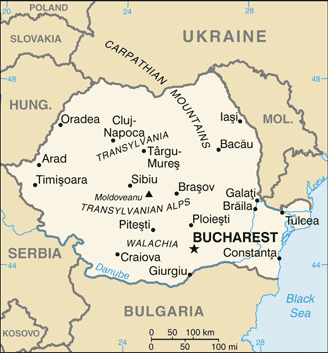Topics Covered
Welcome to Romania
Overview of Resources
Industrial Minerals
Metals
Fossil Fuels
Investment
Sources
Welcome to Romania
Romania, with a total population of 21,848,504 as of July 2012, is located in Southeastern Europe, bordering the Black Sea, between Bulgaria and Ukraine. The country mostly has a temperate climate and covers a total area of 238,391 km2.
The principalities of Moldavia and Wallachia gained independence from the Turkish Ottoman Empire in 1856 and they were formally united in 1862 and henceforth named as Romania. However, it was only in 1878 that Romania’s independence gained recognition. In 2004, Romania joined NATO and in 2007 it joined the EU.
 |
The national flag of Romania.
Image Credit: CIA Factbook. |
In 2000, the country emerged from a three-year recession due to an increasing demand in the export markets of the EU. The country’s GDP at this time saw a tremendous growth as a result of domestic investment and consumption.
In 2009, Romania’s GDP dropped down by more than 7% due to the global recession. As a result of this, $26 billion was availed by Bucharest from the EU, the IMF and many other international leaders.
In 2011, the Romania’s economic growth rate saw a steady increase because of the country’s flourishing export business. The country’s GDP as of 2011 was $270.6 billion.
Overview of Resources
Romania’s key natural resources include natural gas, iron ore, petroleum and coal. In 2010, the country’s mineral production sector was of less global significance and the mineral industry depended on imports of concentrates and mineral ores to carry out the production of refined metals.
Being a member of the EU, Romania saw improvement in its mining activities for lead, zinc, iron ore and copper. This membership boosted the mineral industry’s access to European markets and made way for the development of trade and investment opportunities.
Industrial Minerals
Romania’s investments in its existing plants led to an increase in the production of cement in 2010. The details given below highlight the cement output capacity of three major cement companies in Romania in 2010.
- Carpatcement Holding S.A. increased the cement capacity at its plant by 1.4 Mt/yr
- Holcim (Romania) S.A. increased the cement capacity of its plants by 1 Mt/yr
- Lafarge Ciment S.A. increased the cement capacity at its plants by 0.4 Mt/yr
Metals
In 2010, Romania had two alumina plants each owned by Alum S.A. and Cemtrade Central European Aluminum Company Group (CEAC). About 450,000 Mt of alumina was produced in the same year by the Alum plant. The CEAC plant, on the other hand, remained closed in 2010 and production in this plant stopped in 2006.
In 2010, Gabriel Resources Ltd., a Canadian company, operated the Rosia Montana gold project in northwestern Romania. The company estimated the production capacity of this project at an average of 15.89 Mt/yr of gold, which will make Romania a chief producer of gold in Europe.
In 2010, Sometra S.A.was Romania’s only existing chief producer of zinc and lead. Production activity in this company was suspended in January 2009 due to decreasing demands for the company’s products and also because of the difficulty in getting zinc and lead concentrates.
Fossil Fuels
Zeta Petroleum recently decided to start its Bobocu gas field project that aims at identifying mean contingent gas resources of 44.8 Bcf of gas along with mean prospective gas resource of 68.73Bcf or 11.82MMboe. Gas discovered during this program will be sold to buyers in the Romanian and European markets.

The map of Romania. Image Credit: CIA Factbook
Investment
Recent reports on the Rosia Montana gold mining project in Romania highlight the environmental risks that this project is likely to pose. The Romanian people are against this project as the mine would pollute a number of rivers, destroy four forested mountains and devastate the country’s fragile ecosystems. The Romanian people were also upset over the fact that the government had accepted this project without consulting the local people.
A number of US companies are also attracted to the shale gas resources available in Romania and recent reports highlight that the proposed shale gas projects like the Rosia Montana gold mining project will harm the environment.
Though these projects could uplift the country’s economic status, experts feel that the government should also focus on protecting its people rather than favoring foreign investors.
Increased production in Romania’s mineral industry will depend on the usage of modernized facilities to keep up to the EU standards and also on the growth rate of the European economy. To obtain recognition in the global market, the country’s mineral production sector will thus have to adapt a modern outlook to improve its production facilities.
The country is likely to attract foreign investors in the future as it is keen on continuing its modernization process and Romania’s mineral industry will also likely experience steady growth because of the country’s easy access to the EU markets.
Disclaimer: The Author of this article does not imply any investment recommendation and some content is speculative in nature. The Author is not affiliated in any way with any companies mentioned and all statistical information is publically available.
Sources
Disclaimer: The views expressed here are those of the author expressed in their private capacity and do not necessarily represent the views of AZoM.com Limited T/A AZoNetwork the owner and operator of this website. This disclaimer forms part of the Terms and conditions of use of this website.